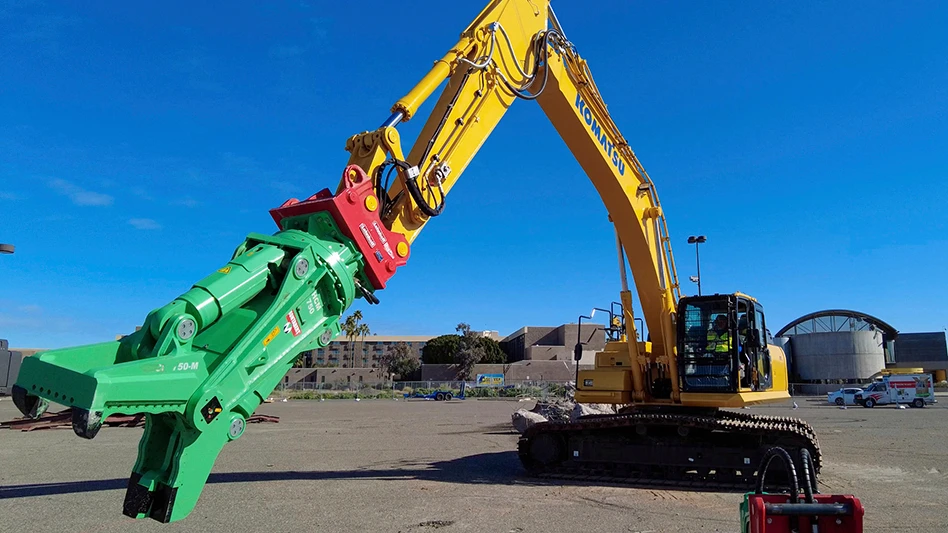
While procuring building materials for large real estate developers in New York City, Amanda Kaminsky and her team found that some of the systems to recycle and reuse construction and demolition debris were “far from perfect.”
Kaminsky founded Building Product Ecosystems LLC, New York,--a collaboration between building owners, construction management teams, gypsum wallboard manufacturers, concrete producers, recyclers and government agencies--to improve the management systems of major building materials. Kaminsky recently talked about the successful closed loop system being established for gypsum wallboard during April’s Sustainable Materials Management webinar series, presented by The National Recycling Coalition (NRC), Washington, and Pennsylvania Recycling Markets Center.
The U.S. Environmental Protection Agency (EPA) estimates 584 million tons of construction and demolition debris is generated per year in the U.S., twice the amount of municipal solid waste (MSW) that is generated per year. Of that, 13 million tons, which Kaminsky says is a “conservative” estimate, is gypsum wallboard. Two percent of gypsum is recycled back into new wallboard. The EPA estimates 75 percent of gypsum debris stems from demolition projects, while 25 percent comes from new construction trim scrap.
Beyond the environmental impacts, “We’re throwing away valuable resources when we’re not recycling this material,” Kaminsky says. “In landfills, when materials are layered on top of other materials in humid, anaerobic conditions, we can see hydrogen sulfide generation. Gypsum is a major contributor to hydrogen sulfide gas, which is associated with the ‘rotten egg’ smell people are familiar with."
Hydrogen sulfide gas can have “significant health impacts” for communities around landfills, from asthma to severe cognitive impacts, which has led communities across the country to speak up about concerns. In some cases, landfills have been put on notice or denied renewal licenses.
“Landfills are remediating by venting or covering,” Kaminsky says. “Some of these solutions are band-aids that don't address the source of the problem. We have a lot of room for progress in how these problems are remediated closer to the source.”
Simultaneously, landfill capacities are projected to drop over the next five years and municipalities are considering what their role is to manage procurement of post-consumer recycled content in materials, as well as how to manage demolition and construction to “optimize the whole system for different building materials,” Kaminsky says.
While these concerns have led to gypsum landfill bans and reuse requirements in Europe and British Columbia, regions in the U.S. are just starting to push policies to improve the system. An ordinance in Seattle requires all construction and demolition projects to “separate new construction gypsum scrap for reuse" and bans the material from being “deposited in construction and demolition site garbage containers for disposal.”
However, for a closed loop system to be successful, end markets and collaboration between construction sites and manufacturers need to be established.
“It’s not always easy to add this layer of care, but it’s very important,” Kaminsky says. “The stakes are high."
In N.Y.C., this has required a change of mindset on renovation and new construction sites to source separate. Some project teams have designated some of their existing laborers to a dedicated drywall cleanup crew, to collect the clean scrap material in mini containers or hampers on site, if space is constricted, and then bring it to a central recycling container or loading dock at the end of the day. One of the N.Y.C. construction teams fills a dedicated 30-yard container with gypsum every two days.
“I was surprised once we got started, there was little to no impact on the things I care about, which are time, schedule, budget. We’re able to get a recycling program for sheetrock and have very little impact on the job,” says Vinnie Teklits, executive superintendent at Hunter Roberts Construction Group, who has played a “pivotal role” in closed loop gypsum recycling in N.Y.C.
Building Product Ecosystems’ online interactive map shows active gypsum wallboard project sites, haulers, processors and manufacturers around the region. It also shows the movement of gypsum from New York City construction sites to recyclers, including Cardella, New Jersey, to USA Gypsum, Denver, Pennsylvania, where it is processed, and then to USnited States Gypsum, Washingtonville, Pennsylvania, where the recycled gypsum feedstock it's remanufactured into new wallboard and supplied back to New York building projects.
Some active projects recovering gypsum include two “large Google development projects,” in which gypsum wallboard manufacturers PABCO, Newark, California, and National Gypsum, Richmond, California, are collaborating with construction teams on a new construction closed loop gypsum trim scrap takeback program in San Francisco, California. The VIA 57 West building in N.Y.C., alongside the Columbia Manhattanville project, have been among the first pilot projects to recycle new construction gypsum trim scrap, Kaminsky says.
Currently, Building Product Ecosystems is collaborating with the Gypsum Association and and the Construction & Demolition Recycling Association (CDRA) to develop quality standards for recycling new construction trim scrap to help ensure the coordination and quality of this material reuse, from construction sites to recycling facilities to gypsum manufacturers.
“We’re taking what has been a very linear system and inserting a loop option that greatly diminishes material going to landfill," Kaminsky says.
Latest from Construction & Demolition Recycling
- Radius loses money, says merger on track
- Cielo investor requests annual meeting
- CDE sets up washing plant on Long Island, NY
- NWRA: NIOSH cuts a step in the wrong direction
- Ferrous price hikes could be poised to pause
- Northstar secures 15-year lease extension for asphalt shingle recycling facility
- Greenwave asks for SEC filing extension
- Construction Plastics Initiative lines up projects





